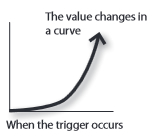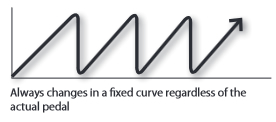To follow these instructions, you should be familiar with the ASSIGN section of the GT-8.
Input Level
You can use your guitars input level to control parameters. The INPUT LEVEL provides you with a sensitivity control that displays at the end of the VARIABLE assign list.
Start by setting the sensitivity to 100, and then set the volume on your guitar to where you would like the change to occur. Once you have determined a suitable position for your guitars volume control, you can adjust the sensitivity parameter accordingly until the change occurs.
Example 1: Use the INPUT LEVEL to control the “Sustain” setting on the compressor. This will produce more sustain as you pick harder.
- ASSIGN1
Target: CS: Sustain
Min: 17
Max: 93
Source: INPUT LEVEL
Mode: Normal
Act. Range Lo: 0
Act. Range Hi: 127
- Sensitivity: 45 (This setting will differ for your own input level.)
- Ensure the compressor is turned ON.
Example 2: Use the INPUT LEVEL to engage the noise suppressor (NS) for low volumes. The DELAY LEVEL should be increased for higher volumes.
- Ensure the NS and DELAY are turned ON.
- ASSIGN1
Target: NS: Threshold
Min: 95
Max: 14
Source: INPUT LEVEL
Mode: Normal
Act. Range Lo: 0
Act. Range Hi: 127 - Set the NS RELEASE to 0.
- ASSIGN2
Target: DD: Effect Level
Min: 18
Max: 40
Source: INPUT LEVEL
Mode: Normal
Act. Range Lo: 0
Act. Range Hi: 127 - Sensitivity: 48 (This setting will differ for your own input level.)
Internal Pedal
The Internal and Wave pedals function as a virtual expression pedal. The Internal Pedal responds with a single movement of the virtual expression pedal (activated by a trigger,) while the Wave Pedal fluctuates in movement.
The Internal Pedal allows you to assign a trigger to activate it. The options are displayed when INTERNAL is selected. Apart from assigning the trigger to the CTL pedal or expression pedal switch, you have a few more choices:
- PatchChange: Activated when the patch is selected.
- EXP PEDAL-L: Activated when the expression pedal is in the heel down position.
- EXP PEDAL-M: Activated when the expression pedal is in the middle position.
- EXP PEDAL-H: Activated when the expression pedal is in the toe down position.
- MIDI CC: Activated via a MIDI Control Change message.
Two more options are presented for the Internal Pedal:
- Time: The time needed for the virtual expression pedal to move from the heel down position to the toe down position.
- Curve: This can be linear, a slow rise, or a fast rise.


Example: Use the CTL pedal to trigger an automatic pitch shift.
- Set FX2 to “Pitch Shift.”
- Disable the CTL pedal in the CTL/EXP section.
- ASSIGN1
Target: FX2 ps: PS1 Pitch
Min: -2
Max: 0
Source: INTERNAL PEDAL
Mode: Normal
Act. Range Lo: 0
Act. Range Hi: 127
Trig: CTL PEDAL
Time: 5
Curve: Slow Rise
Wave Pedal
This changes parameters in accordance to a selected waveform. The RATE parameter determines the time spent for one cycle of the virtual expression pedal.


Example: Use the CTL pedal to trigger a Ring Mod, which automatically adjusts the Frequency based on a sine wave.
- Set FX1 to “Ring Mod.”
- Disable the CTL pedal in the CTL/EXP section.
- ASSIGN1
Target: fx1: On/Off
Min: Off
Max: On
Source: CTL PEDAL
Mode: Normal (this will trigger the effect only while the CTL pedal is depressed.)
Act. Range Lo: 0
Act. Range Hi: 127 - ASSIGN2
Target: FX1 rm: Frequency
Min: 0
Max: 48
Source: WAVE PEDAL
Mode: Normal
Act. Range Lo: 0
Act. Range Hi: 127
Rate: 69
Waveform: SIN
